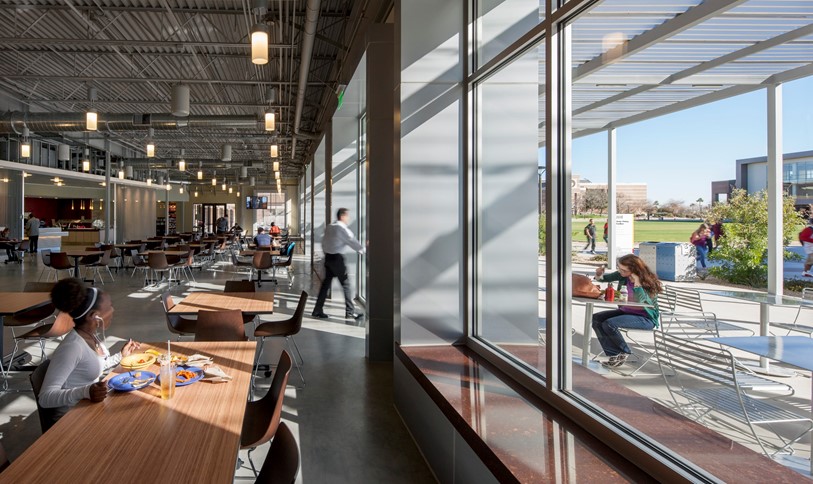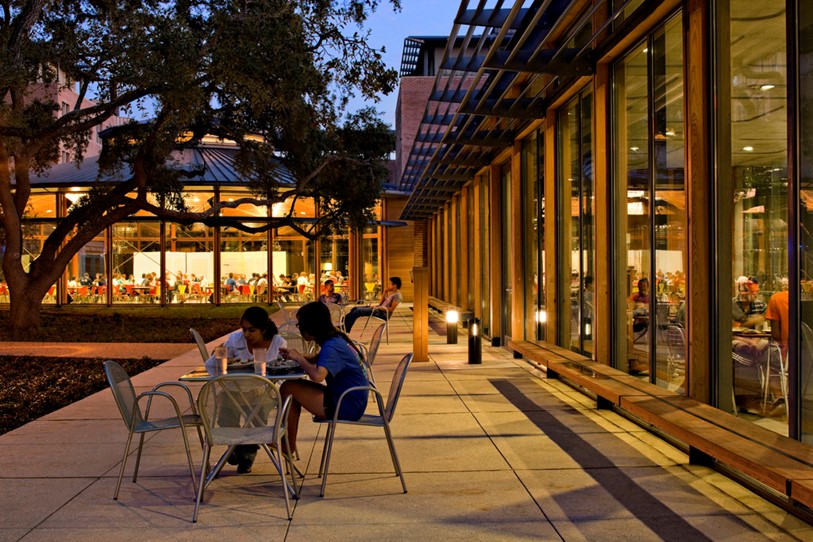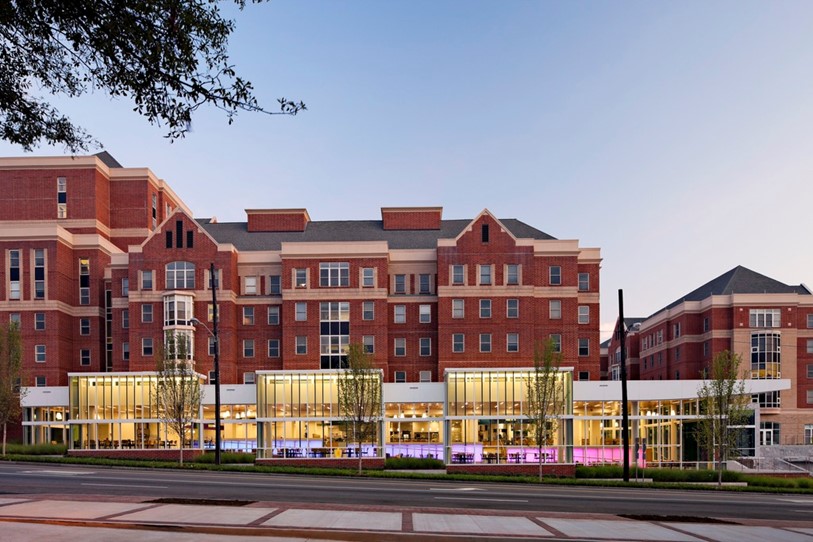Dining as Heart of Campus
Views of towering peaks. Scores of food choices. Open floor plans. Lots of glass.
New dining facilities on college campuses are incorporating these and many other features. Going, going, gone are cafeteria-style halls with rows of white tables stacked up under unkind—and mood killing—fluorescent lights.
We see these trends in dining design as ones that will go far beyond the food. A recent Y-Pulse survey of college students found that six in 10 wished the college dining hall “was more of an experience.” The researchers noted that students now expect dining programs to, not only reflect their values and ethics in the food, but in the location and in their “messaging” too.
Along those lines, we see campus dining as now more akin to the restaurant experience vs. the cafeteria one and, as such, another big opportunity for designers to boost engagement and community among students and staff.
Numerous studies have shown how important engagement is in just about any population. Engaged workers are more productive. Engaged students are more likely to graduate. Buildings can improve productivity and performance by as much as 12.5 percent or reduce them by as much as 17 percent, research suggests.
So, how is this all being reflected in student dining facilities on U.S. college and university campuses? We see these top-level trends driving today’s design, including new facilities that are more:
Extroverted.
Who doesn’t recall standing in the cafeteria line, food tray in hand, passing dishes of mystery meat and scalloped potatoes, grabbing your drink and heading out into a cavernous hall filled with seemingly happy students all engaged with each other — but not one of whom looks back at you? Most of us, at one time or another, probably faced that awkward situation, made a beeline for the first empty table, ate and peeled off, pretending to need to be somewhere else.
Much like highways direct traffic, the design of a space directs the flow of people. But taking the route of least resistance is not always the most enriching one. Older dining halls were built with more of a factory-floor efficiency, moving students from one place to another and making sure each of them passed by someone to check off a meal card.
Today’s new dining facilities are defined more by transparency and light and less solely by efficiency. For instance, we see much more glass in dining areas. That enables more natural light and gives students visual previews as to who is already in the space, or what is going on. Not only does that enable more students to engage with each other, but it gives the more introverted students a more gentle way to enter the space and the flow of community.

We also see more pathways next to dining areas so, again, students can warm up to a space or activity. The pathways, if outside, are linked to what’s going on inside because barriers are glass, or low enough to be seen over. The new Verde Dining Pavilion at Arizona State University, for instance, invites students to enter the space from all kinds of different places. No more single checkpoint. At Georgia Tech, students walking down a sidewalk now have people next to the them eating. That makes for less formal, and easier, connections.
Dining facilities are also being used more often in parts of campus where there are few other social gathering places. These spaces, whether full-fledged or cafe in nature, enable mingling, joint studying or simply hanging out. All of this boosts the time that students spend on campus, which, as studies have shown with on-campus residential living, often enhances academic performance.
Full of choices.
Rather than cafeteria style, campus dining today is more akin to food courts, mini restaurants and marketplaces. In a survey of 1,000 college students, market researcher, Datassential, found that the majority want “made-to-order, fresh, healthy foods that are also customizable and fast – the same things consumers overall are pushing for.” Variety is key. Half of all millennials—the age group of 18 to 34 year olds—consider themselves “foodies,” indicated a survey of 1,000 by marketing firm BBDO Atlanta. The expansion of food choices does more than pander to millennial tastebuds. It reflects expansive societal attitudes toward food and the connection between it, community and engagement.
Connected.
The physical and the digital worlds are ever more connected. Students are masters at being in a physical space at the same time they engage with the digital world via smartphones and social media outlets. Dining spaces, while intended to feed the body, must also now meet social networking needs. As such, campus dining areas are also recharging stations and workplaces, much like just about every Starbucks coffee shop. More than eight in 10 students also now want campus food service information conveyed to them via social media, Y-Pulseresearch shows.
Interactive.
Dining halls that sit empty much of the time are increasingly rare. Flexible space is critical and more dining halls now have moveable walls so smaller spaces can be created out of big ones, or areas where food service is available almost 24/7. More spaces are also being designed to draw in student groups, gatherings, meetings, and the like. To accommodate all kinds of uses, we see better lighting, ceiling treatments, colors, finishes and furniture—all of which entices students to stay and establish a sense of community. At Arizona State University, Verde Dining is becoming the social hub of the campus by hosting student meetings, service clubs, festivals and special events. The area also includes a new housing and a recreation center. The three created a “synergy,” that helps attract and retain students.

Outdoor Connected.
The new Roaring Fork Dining Hall at the University of Colorado in Colorado Springs features windows on three sides and an outdoor deck facing Pike’s Peak. Not every campus has such a tremendous natural wonder but more are making use of what they’ve got. The University of North Dakota, for instance, now has walls of glass in Wilkerson Commons which infuses the dining areas with natural light and rids it of “unappealing dark corners,” wrote Food Management. Reisner Hall at Shippensburg University has an L-shaped dining area offering views of campus from every table.
These trends—and many more—all point to a big shift in campus dining. It now has far more to do with the student experience than merely providing sustenance. Whether studying, socializing, relaxing or celebrating, connecting with others over food on campus serves many important academic and social functions. More than ever, dining is at the heart of student connections and student life.
Written with contributions from Matthew Lee, CID, ASID, LEED AP BD+C

